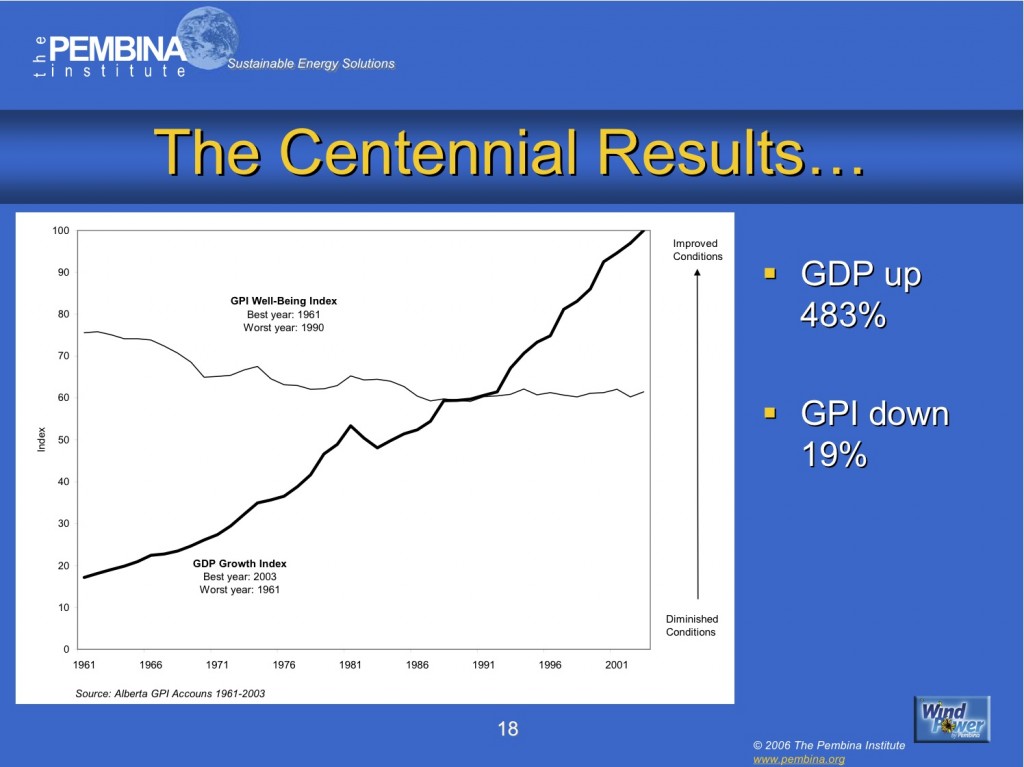Alison Smith Critical Response 1: GDP vs. GPI
Basing countries over all well-being or success solely on GDP is neither an accurate nor a constructive means of measure. As thoroughly explored by James O’Connor, Marx had acknowledged the ignored variables that fuel capitalism and dubbed them production conditions. Our class is acutely aware that GDP is a poor measure when assessing economic, social and environmental welfare simultaneously. Therefore it would be beneficial to examine the GPI (Genuine Progress Indicator) as a replacement for the GDP.
O’Connor states, “We need a more refined theoretical approach to the problem of…land and labor,” and in 1995 three economists, Herman Daly, John Cobb and Philip Lawn asserted that the accounting for the GDP was fundamentally misguided and introduced the foundations of the GPI. The major distinction between the two metrics is the categorization of a ‘cost’ and a ‘benefit.’ The GDP measures all production, but does not account for what is required and or demolished for the production. For example, the GDP includes crime as a benefit because the monetary exchange that accompanies property repair, legal fees or medical bills add to the accumulation of wealth and increases the GDP. Additional examples of how social or environmental crisis are valued to the budget of the GDP are natural disasters such as hurricanes or corporate neglect such as oil spills. The destruction of Hurricane Andrew in 1992 actually increased Southern Florida’s GDP due to development repair and rescue funds. Not only does the GDP mask the break down of social structures and natural habitats and resources, it actually portrays such breakdowns as economic gain.
The majority of North Americans have a misconception about the GDP embedded in their brains. The associations of growth and individual wealth are synonymous with the exponential trend of the GDP (the increasing gradient in the graph.) The concept of what O’Connor calls ‘limits to growth’ is a dominant force in why politicians, economists and citizens alike are not quickly encouraging the use of the GPI. It is apparent that the GPI lacks the ease of calculability of that of the GDP. It is very hard to measure the effects of economic growth such as resource depletion, ecological harm, social destruction and inequalities in a concise tangible denomination. For this reason the GPI for Alberta (created and researched by the Pembina Institute) is expressed in a monetary value, however the parameters of its calculations include 51 indicators of well-being. Where GDP is only 1 of the 51 indicators. The gap between the rich and poor, house hold debt, problem gamblers, obesity, timber sustainability and volunteerism are just a few indicators that contribute to a more balanced and accurate account of societies progress. It is interesting to note that as Alberta’s GPI is leveling out the GDP is continually rises, at the expense of economic, social and environmental conditions.
As much as I personally believe the GPI is a superior metric I still have doubts about how these indicators are actually measured and I am also slightly skeptical of who establishes these parameters of measurement. The information The Pembina Institute offers is exceptionally thorough, and allows access to the methodologies and results to all 51 indicators. However, each indicator is indexed to the GPI standard by different approaches and this makes the metric an extremely complex and dynamic system. The GPI is far more difficult to fully comprehend than all the aspects of the GDP and takes a great deal of time and research to get it initiated. I hope this system continues to expand in popularity because it is a step in the right direction of real accountability of economic expansion.
Graphs and Table source:
Taylor, Amy. “Measuring Progress in Alberta: The GPI.” March 2006. The Pembina Institute: Sustainable Energy Solution. 10 October 2010 <http://www.pembina.org/economics/gpi/alberta>.


0 comments
Kick things off by filling out the form below.
Leave a Comment